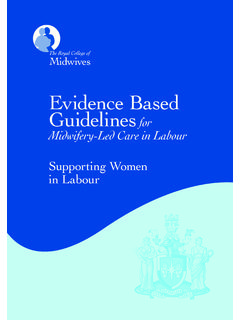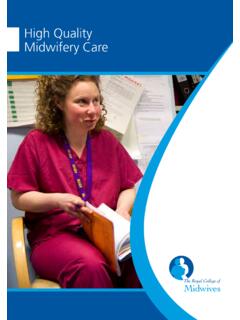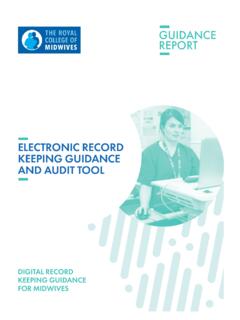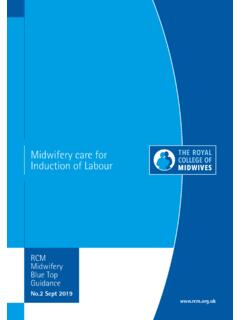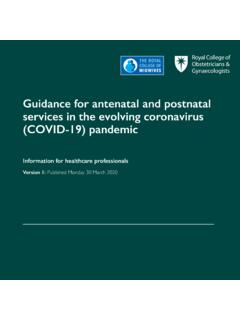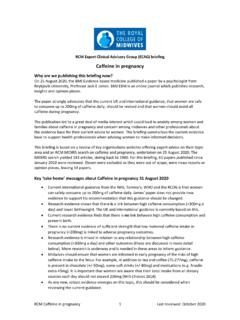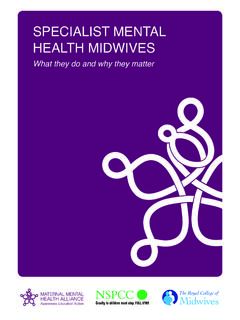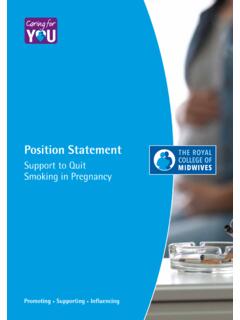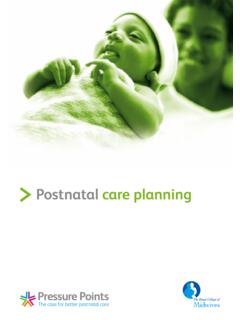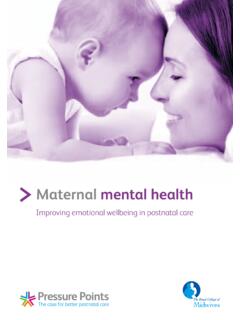Transcription of Getting the midwifery - RCM
1 The midwifery workforce right1 | The Royal College of MidwivesGetting the midwifery workforce | 2 Key messages The role of the midwife is clearly described and demarcated. The evidence shows that it is in the interests of women to receive the majority of their care from a small group of midwives they know and trust. midwifery services should be staffed to enable this to happen. The role of the midwife has developed over the years to meet changing population needs and in a changing context of healthcare delivery.
2 The role of the midwife can encompass new tasks but this should always be a) in the interests of women and their babies b) properly resourced c) supported by defined competencies and appropriate education and d) within their scope of practice. When a midwife takes on new tasks this does not equate to taking on a specialist or advanced role. A midwife may focus her skills on a specific group of women teenage mothers, women with drug or alcohol problems, safeguarding etc. This does not make her a specialist or advanced midwife.
3 A specialist midwife would be expected to play a more strategic role in service delivery. A specialist midwife would be expected to receive referrals from other midwives or GPs when care was particularly complex. She would also be expected to network amongst other services, have a role in policy influencing and setting for that service and a key role in education. Specific local circumstances primarily related to size of service and rural services may exceptionally mean it is appropriate for a midwife to undertake tasks which in another context are usually performed by other professionals scrubbing in theatre or undertaking ventouse deliveries.
4 Support workers play a vital part in maternity teams. They may be employed in clerical, housekeeping or care giving roles. MSWs in particular make an important contribution. There should be a nationally agreed framework with competencies for such roles supported by national training programmes. There is no need for a nurse associate role in maternity services. Consultant midwives have clearly defined roles, make an enormous difference to the clinical leadership and practice development within units as well as being the catalysts for change and | The Royal College of MidwivesGetting the midwifery workforce | 4 Role of the midwifeThe role of the midwife is to ensure that women receive the care they need throughout pregnancy, childbirth and the postnatal period.
5 Much of this care will be provided directly by the midwife, whose expertise lies in the care of women and babies during normal birth and pregnancy. Where obstetric or other medical involvement is necessary, the midwife continues to be responsible for providing holistic support, maximising continuity of carer and promoting a positive birth experience for the way in which the role of the midwife evolves and develops over time may have significant implications for the overall focus and quality of midwifery care, on the best use of resources and on the midwifery profession itself.
6 That is why the RCM has developed this guidance for midwives, MSWs, other members of the maternity team, midwifery service providers and policy of the roleThe formal definition of a midwife that has been adopted by the International Confederation of Midwives (ICM), the International Federation of Gynaecologists and Obstetricians (FIGO) and the WHO reads as follows: A midwife is a person who, having been regularly admitted to a midwifery educational programme, duly recognised in the country in which it is located, has successfully completed the prescribed course of studies in midwifery and has acquired the requisite qualifications to be registered and/or legally licensed to practise must be able to give the necessary supervision, care and advice to women during pregnancy, labour and the postpartum period.
7 To conduct deliveries on her own responsibility and to care for the newborn and the infant. This care includes preventative measures, the detection of abnormal conditions in mother and child, the procurement of medical assistance and the execution of emergency measures in the absence of medical help. She has an important task in health counselling and education, not only for the women, but also within the family and the community. The work should involve antenatal education and preparation for parenthood and extends to certain areas of gynaecology, family planning and child care.
8 She may practise in hospitals, clinics, health units, domiciliary conditions or in any other service. IntroductionMaternity services like the rest of the NHS are facing severe financial challenges. The paradox for everyone involved in funding, managing and delivering maternity services is how on the one hand: The NHS could and should raise its game on personalised support to parents and their babies, better team working, better use of technology and more joined up maternity services (Simon Stevens, CEO NHS England)But on the other hand.
9 Cuts in staffing and reduction in quality are inevitable if the government s priority is to restore the NHS to financial balance (Kings Fund 2016)In order to try to bring some clarity into debates, policies and decisions about how maternity services should be configured, funded and staffed, the RCM has developed this guidance which explains the role of the midwife, the limits and scope of the role, its relationship with other professionals and care givers and the approaches which are most likely to lead to safe and effective staffing | The Royal College of MidwivesGetting the midwifery workforce | 6 Thinking about midwifery in 2016 The role of the midwife as primary carer for women and infants experiencing normal pregnancy and birth has remained essentially unchanged for many years.
10 The value of this role lies in midwives extensive knowledge, expertise and their ability to detect and act appropriately on a wide range of clinical and other indicators in pregnancy, labour and the postnatal is very much relationship-focused rather than providing task or intervention based care. It has its biggest impact on outcomes where midwives are able to provide consistent care over the continuum of antenatal, intrapartum and postnatal care. The intention of delivering continuity of carer of each pregnant woman seeing as few different health care staff as possible, is central to policy for maternity services across the UK.
